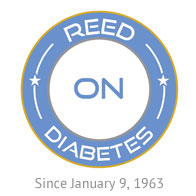After leaving both the family nest and college cocoon, I entered the real world. It was 1981 and I had a good job with a public accounting firm in Kansas City. Now on my own and single, I was experiencing way too many lows amidst the erratic way I was living. I wasn’t a good or patient cook, so I ate different things for breakfast, lunch and dinner. I enjoyed working out, so I exercised a lot. I found my work as an accountant challenging and that added a new type of stress. I had a good and wide social network and enjoyed spending evenings and weekends with friends.
During this time I remember two moments of truth with my diabetes. The first was being so low and confused one afternoon at work during busy season (that’s January to April for accountants) that I staggered to the break room. I found the vending machines, sat down and ate as much as I could. I felt like a wet noodle. And this wasn’t an isolated incident. But it was the point where I knew I had to find a better way. So, later that night I opened the phone book and wrote down the number of my first endocrinologist.
The second moment happened two years later in 1985 when I worked at AT&T. After working two years for them in Kansas City, I accepted a transfer to Atlanta and was waiting for the moving van to arrive. With most of my things packed, I sat on the bed next to a phone waiting for a call from the driver. When the call came, my arms were too numb to pick up the phone. It scared the shit out of me. Was this the beginning of neuropathy?
I remember both of these as the defining moments where I accepted and embraced my diabetes. Since that time I’ve studied, learned and challenged the standards of care for my diabetes. Counter to what I was taught as a teenager, I found that exercise helped. When I proposed injecting regular insulin before every meal to an endocrinologist, he asked why I would change when two injections a day were providing an acceptable A1C (ok that was 1984). I told him I preferred to eat when I wanted to eat, not when the NPH kicked in. I researched and went on an insulin pump in the 1980s. I couldn’t wait for a faster acting insulin, Humalog, to arrive in 1996. I was one of the first people in Kansas City to receive a continuous glucose monitor in 2006.
I’m grateful for my decision to finally embrace diabetes and seek the best knowledge, meds and technology available to manage it. Sometimes we look outside for solutions, when the answer starts within.

